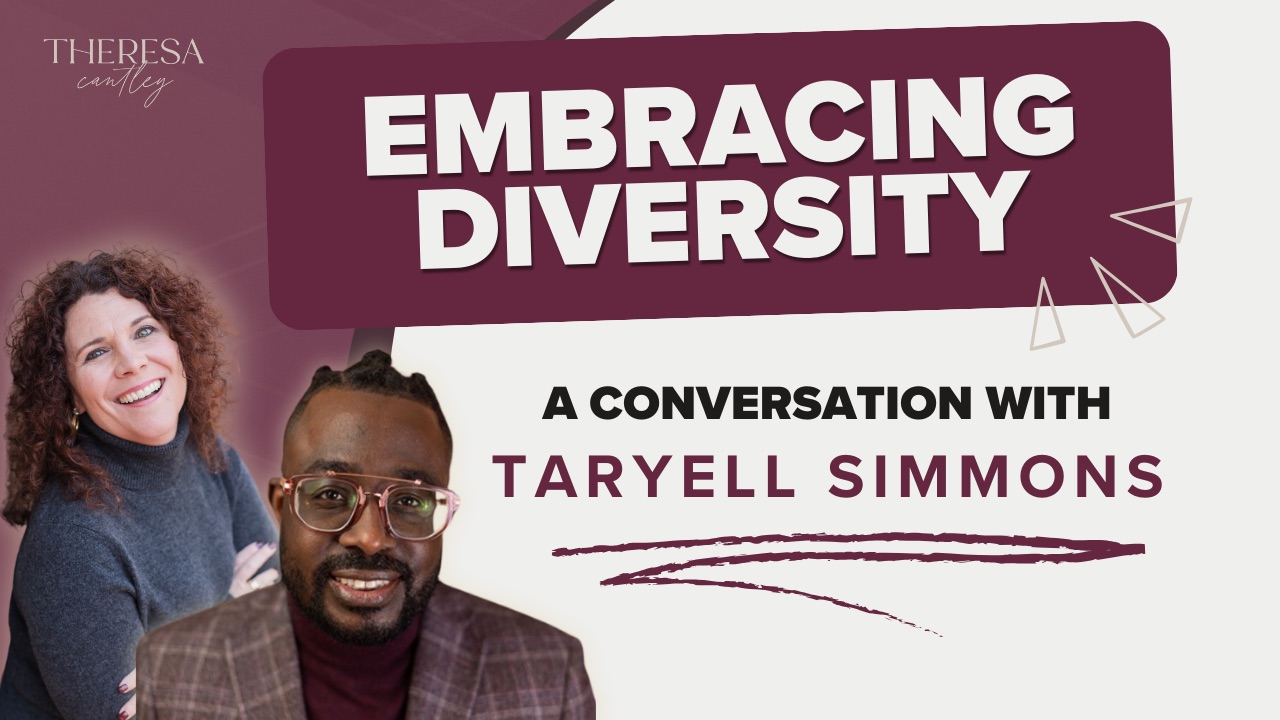On this episode of The C-Suite Mentor, Theresa Cantley chats with DEI consultant and podcast host Taryell Simmons to talk about something that’s not only close to his heart – but critical to the future of work: neurodiversity in the workplace.
Taryell is breaking down what exactly neurodiversity in the workplace means, why people are so resistant to workplace change, and how we can start to build a better future for everyone.
Who Is Taryell Simmons?
Before diving into the work he does today, Taryell shared his story, starting in Rochester, New York and Washington, D.C. Raised by a New York-born mom and a Nigerian father, Taryell grew up at the intersection of two cultures. He also came of age in a D.C. that was, at the time, labeled the murder capital of the U.S.
And like many neurodivergent kids in that era, he found himself caught in a school system that didn’t fully understand or support him. Diagnosed with ADHD early on, Taryell explained that his parents didn’t want him labeled or limited. But without the proper resources or understanding, he struggled.
It wasn’t until adulthood that things started to click. As he learned more about neurodiversity – a term that includes ADHD, autism, dyslexia, and other ways of thinking – he began to understand himself better. And more importantly, he realized how much society is missing by not creating space for neurodivergent thinkers.
What Does Neurodiversity in the Workplace Mean?
Taryell defines neurodiversity as a term that simply means people experience and interact with the world in different ways. From seeing numbers as colors to experiencing heightened senses or analytical superpowers, neurodivergent individuals bring unique skills to the table.
But here’s the problem: most workplaces are designed for neurotypical brains.
Think: harsh fluorescent lights, constant noise, rigid time tracking, and environments that don’t allow for flexibility or sensory accommodations.
Taryell shared a powerful metaphor: imagine if someone could see in the dark. In a military setting, that would be considered a superpower. So why, in the workplace, do we treat that kind of difference as a deficit?
It’s time to shift our thinking from trying to “fix” neurodivergent individuals to embracing neurodiversity in the workplace, so we can include and empower everyone.
From DEI to Ubuntu: Building Better Workplaces Together
Taryell’s consulting work in Diversity, Equity, and Inclusion (DEI) is focused on collective impact – a concept rooted in the African philosophy of Ubuntu, which means “I am because we are.”
Rather than putting people into boxes, or even thinking outside of them, Taryell encourages us to burn the box down entirely – a nod to a friend’s take on how neurodivergent folks think. It’s about reimagining the entire system so that everyone has the opportunity to contribute in their own way.
Because when we embrace neurodiversity in the workplace, we make work environments better for everyone – not just those who need the ramp, but also those pushing strollers, riding bikes, or carrying deliveries.
Systemic Racism and Problems with the System
Imagine walking by a lake and spotting a single fish floating belly up. Your first instinct might be to wonder, “What’s wrong with that fish?” Was it sick? Did something happen to that particular fish?
Now imagine you keep walking and see five more dead fish. At that point, you’d probably stop blaming the fish and start asking, “What’s wrong with the lake?”
Now picture five lakes across the country, all with the same problem – dead fish. It’s no longer just about the individual lakes. Now, we need to ask: What’s wrong with the groundwater?
This is the analogy Tayrell Simmons used to explain the impact of systemic racism and deeply embedded societal issues. Just like most of the Earth’s water is underground, the forces shaping our society are often invisible but incredibly powerful.
The system isn’t broken – it was built that way. And if we want different results, we have to go deep and redesign the foundation.
Fear of the Unknown
However, fear of change and resistance to the unknown often hold us back. This resistance plays a big role in how organizations fail to embrace neurodiversity in the workplace – because real inclusion asks us to go deeper than surface-level DEI initiatives.
Tayrell used the analogy of someone stuck in a toxic relationship to explain how people often default to what’s familiar, even if it isn’t healthy. Similarly, businesses sometimes cling to outdated systems and workplace cultures that exclude or misunderstand neurodivergent individuals. Why? Because embracing a healthier, more inclusive model would require inner change – and that’s hard work.
Layers of Labels, Stigma, and Resistance
Instead of doing the deep work, many people layer on labels, systems, or excuses. Theresa pointed out that people often don’t want to address the beliefs or trauma underneath those layers. And in the workplace, those layers can turn into policies or assumptions that keep neurodiverse employees on the margins.
Real change requires us to break through those walls.
Individual Growth Fuels Collective Change
Collective change starts with individual transformation. We can’t create inclusive environments for others – especially those who are neurodivergent – if we haven’t examined our own biases, fears, and beliefs.
This work involves both unlearning outdated mindsets and relearning how to build systems that actually serve all people, not just the neurotypical majority.
Resources Mentioned
💻 Join me every Friday at 10 am on LinkedIn for my free workshop
☕️ Schedule a Virtual Coffee with Theresa
📝 Uncover Your Biggest Blindspots with the Entrepreneur Quiz
Related Episodes
Are You Depositing or Withdrawing?: 5 Questions Every Leader Should Ask Themselves


